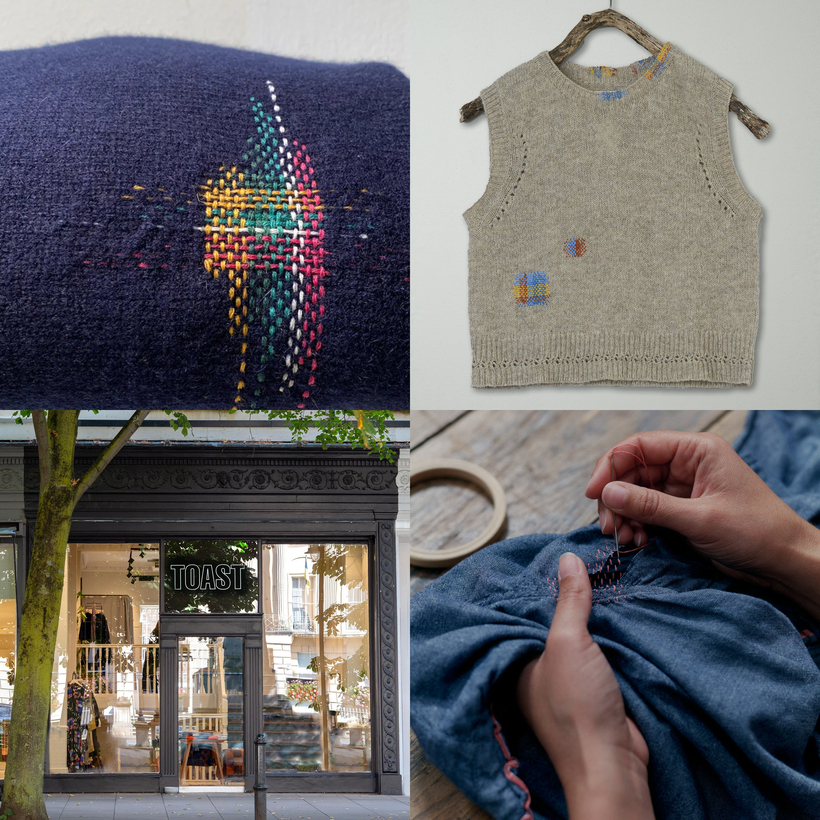In 2018, the New England outfitter L.L. Bean discontinued their famed no-proof-of-purchase lifetime-returns policy, which the retailer had offered since its founding, in 1912. The new policy instituted a dramatically reduced, one-year return window, a sad shift that seemed to suggest the company’s waning interest in engendering customer confidence by producing items with longevity in mind.
That same year, on the other side of the Atlantic, the U.K.-based clothing brand Toast began trialing textile repairs through workshops in their stores. By providing tutorials on traditional craft techniques—such as Japanese sashiko stitching and knitwear darning—for garments in need of mending, the team quickly realized there would be strong consumer interest in a quality repair service. By 2019, Toast Repair was launched as a pilot program in the company’s Notting Hill shop. Customers could bring in worn-out pieces and the shop would repair them for free, with no proof of purchase required.

“When we first introduced the service, we were repairing around 1,600 garments annually,” says Madeleine Michell, Toast’s communications manager. “Today, that number has grown to almost 2,500 repairs a year.” To date, more than 7,000 garments have had new life breathed into them by Toast’s team of repair specialists.
The demand for Toast’s repair service can be put down to a mixture of environmental concern, inflation, and, now, tariffs. Even prior to Trump’s “Liberation Day,” the global market for secondhand clothing has been experiencing explosive growth. Approximately one-third of all apparel bought in the United States over the past year was thrifted.

The year 2023 saw the debut of Toast Renewed, a collection whose “aim was to challenge the notion that tears, holes, and other flaws diminish the beauty of an item,” says Michell. “With each one-of-a-kind piece, we demonstrate how the act of mending can give clothing and soft textiles a new lease of life.” When it comes to items damaged in their shops or warehouse, the Toast specialists opt for visible repairs, rather than discarding the goods, as most fashion retailers do.
“There is something very satisfying about the problem-solving that goes into a repair, making a broken thing whole again,” says Jessica Smulders-Cohen, one of Toast’s repair specialists. “Visible mending can make [a garment] more beautiful than before, which is the Japanese philosophy behind kintsugi.” (Kintsugi, the art of making undisguised repairs in ceramics, lends an object an unreplicable—and arguably enhanced—attractiveness.)

Smulders-Cohen, who started with Toast more than a decade ago, works three days a week at the firm’s Shoreditch location, in London. When she arrives in the morning, there are roughly 30 to 50 items awaiting her repairing skills. The technique applied—Swiss, Scotch, or traditional darning for knitwear; patching and/or stitching for wovens—depends on the fabric and issue at hand.
When a customer comes in, she usually inquires as to how the damage occurred, in order to conceive the best mending plan. For instance, she embroidered moths into a garment to cover holes the destructive pests had made.
Smulders-Cohen comes to see both clothing and customers in a new light when she knows exactly how an item was damaged. “The best story was a woman whose dress got eaten by a horse whilst she was wearing it,” she says. “Not the whole thing, but a decent-sized chunk got taken out of the front panel of the skirt, and the woman was convinced it was the color palette of the check—pale green and golden yellow—that had enticed the animal.”

Seventy percent of the time, customers opt for discreet-looking repairs, hoping to recapture a garment’s original look. The other 30 percent tend to give Smulders-Cohen the creative latitude to embark on visible repairs.
Toast employs six repair specialists across their U.K. locations, and two at their Brooklyn and Manhattan outposts, which opened last year. “I think brands need to be held accountable for the clothes they produce throughout their lifetime,” says Smulders-Cohen. It’s the more artful, sustainable version of L.L. Bean’s former promise. Long may it last.
Spike Carter is a writer and filmmaker


